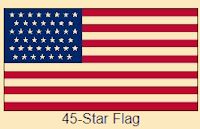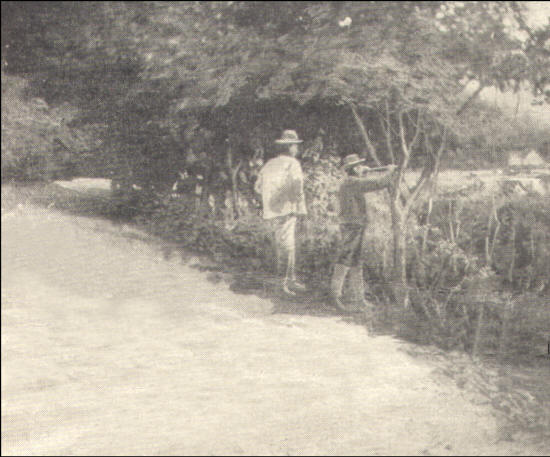Our Clark County, Wisconsin
SPANISH AMERICAN WAR VETERANS

3rd Wisconsin Infantry
THE PUERTO RICO CAMPAIGN
DESCRIPTIVE ACCOUNT OF THE OPERATIONS AND SKIRMISHES ABOUT GUAYAMA,
PUERTO RICO, OCCURRING ON THE 5TH, 8Th, AND l3Th OF AUGUST, 1898.

GENERAL BROOKE STUDYING THE ENEMY'S POSITION
FROM THE EXTREME FRONT, AUGUST 12.
GUAYAMA, PuseTo Rico, August 20, 1898.
The 1st of August saw the landing of General Brooke and staff at Arroyo, on the southern coast, some thirty miles east of Ponce. During the next few (lays General Hams and his brigade arrived on board the transports Seneca and City of Washington, accompanied by the auxiliary cruiser St. Paul. The landing of the troops was un- eventful, save for the throwing of a few shells from the St. Louis and Cincinnati as a warning to some guerillas lurking about the outskirts. Headquarters were established, and on August 4 Brigadier-General Hams received orders to proceed to the town of Guayama with two regiments of his brigade. With the exception of the lack of transportation, which was finally effected by means of native ox-carts, the troops were ready to move. In spite of difficulties, General Hains left Arroyo at half after eight on the morning of the 5dm of August, the Fourth Ohio supplying the advance - guard, while the Third Illinois brought up the rear; the Fourth Pennsylvania was left at Arroyo as a temporary garrison.
It was reported that Guayama, some five miles distant, was extremely Spanish in sentiment, and that the enemy’ troops had gathered there in considerable force. Information in regard to the roads was sadly lacking, and but few trustworthy interpreters could be found. One negro, having previously been an inhabitant of St. Thomas, was pressed into service, and was taken as guide.
About 9.45 a road was reached leading to the right. The information as to its destination being uncertain, it was thought best to leave the Third Illinois at that point as a reserve. This was done, and the Fourth Ohio proceeded along the main road, having thrown out flankers to the right and left, and covering a mile of front, including both wings. In thus formation the advance was made, the main column following along on the road some four hundred yards to the rear. the general and Ins aides a few hundred yards in rear of the point and in advance of the column.
The day was favorable in regard to weather, a slight breeze cooling the air and tempering the heat of the sun. A peculiar dazzling haze covered the lulls with a bluish tint or veil, which made distances uncertain to the eye, and which also blended the blue of the uniforms with the shadows of the undergrowth, so that our flankers were scarcely distinguishable at a distance of four or five hundred yards. General hums, with four of his staff, had proceeded in advance of the column, which had just halted, owing to the difficulties met by the flankers in pushing forward through the brush, and at a point distant about two miles from Guayama the first sigh of the enemy’s presence was noticed; a peculiar, sharply singing “pstwing” was heard tearing its way over our heads, being a sound in winch force amid velocity were so delicately compounded as to seem one amid inseparable. An able called attention to the telegraph wire, which had sagged to the road-side, and insisted that it had been cut; but the discussion was soon ended by the arrival of many more leaden messages bearing the same meaning. The right and left flankers, composed of the Fourth Ohio, were re-enforced and became the firing-line, and the skirmish hind begun. The men in column on the road were drawing most of the fire, amid two of them had been wounded at the first fire. the rest began to tear down the barbed-wire fences beside the road, sought convenient cover, amid awaited orders. the large of the enemy’s fire was evidently a long one, as many of the bullets lay spent at our feet, and the report of the Mausers was not heard until after the song of the bullet. No smoke or flash could be seen in any direction, and it was some the before the enemy’s exact position could be ascertained. Most of the firing seemed to come from a emit in the road some distance ahead, and aides were sent to the firing-lines with instructions to that effect. the enemy’s fire was quite steady, evidently coming from sharp-shooters and guerillas, as no volley-firing could be distinguished. Our firing- line gradually advanced, wheeling slowly to the north, until it finally closed in about the southern end of the town, the entire movement occupying two hours. At this point the enemy’s fire ceased, and the Fourth Ohio advanced cautiously into the town. A few stray shots were fired upon the troops from the houses and roofs, lint they pushed out to the main square or plaza. Here many of the natives rushed forward, throwing their arms about our horses, hugging the soldiers, and shouting ‘‘Vivan Americanos” arid “Perto Rico Americano.” the flag was raised above the city huh, and amid the cheering came the shout, “the Spaniards are coming back,” accompanied by the singing of some score of bullets. Confusion and disorganization seemed imminent; but in a twinkling the general, with four companies of the Fourth Ohio, was at the northern end of the town, from which place the fire seemed to be coming. Here two firing-lines were formed, one facing the north, the other following the direction some Spaniards were taking who were seen escaping to a near-by sugar-plantation northeast of the town.
The firing here lasted about one hour. The majority of the Spaniards had retreated toward the hills in the north and taken imp positions behind houses and rocks, and making good use of the natural cover. the dynamite-guns, under Captain Potter, were finally brought up, and were here used with great effect, five shells being thrown, which silenced the firing very effectively, and the Spaniards retreated north of the town. the advance upon and capture of the town occupied the better part of the day, and the remaining in our or so before night was devoted to the placing of a careful picket and outpost for the town; the Fourth Ohio took up the northern lines, while the Third Illinois was brought in mind placed to the south and west. during the next day or two. Spanish troops were seen by our outposts from time to time, but no engagement took place. On the 8th a reconnaissance was ordered by General Hams to ascertain the nature of the country to the north, and also the strength and location of the Spanish forces. Colonel Coit and Captain Walsh, in command of companies A and C of the Fourth Ohio, accompanied by Lieutenant Darrach of General Hain's staff, left Guayama at about nine in the morning of the 8th and proceeded along the San Juan road for a distance of about two and a half miles. Here the Spaniards could be seen distinctly with the glass, throwing up entrenchments upon the opposite hulls; also small bodies of them moving about upon the side of the mountain some three or four thousand yards distant.
The road on which the troops were proceeding was cut along the face of the hill, and by a circuitous route wound its way around toward the enemy’s position. the point and several officers were advanced some two hundred yards beyond the column, and had gone through two open ledges, by which the road passed the front of the slope. The last company was about to enter the first of these were a terrific volley fire was opened from the Spanish entrenchments. Colonel Colt and two members of General Brooke’s staff, who had ridden up, took shelter behind a house by the road, amid the rest of the command, under Captain Walsh, lay flat upon their faces. A gutter or trench by the side of the road was the only cover, and into that rolled the men, and by its cover managed to crawl around the bend to a place protected from the enemy's fire. Four of the men of C company were found at this point, and the gauntlet had to be run to the next turn, where it was thought company C has assembled. Here, however, but a few men were found, the rest having taken to their heels at the first volley. A firing-line was formed, however, and the wounded brought hack to cover. A few well-directed volleys had returned the enemy’s fire, when reinforcements came up in the form of two dynamite-guns and some companies of infantry under Lieutenant- Colonel Adams. the Spanish soon retreated from their trenches around the point of the most distant turn, amid the reconnoitering party returned with a certain knowledge and remarkable memory of the enemy’s position and strength. The number of the enemy’s troops was thought to be about eight hundred, and was increased by re-enforcements from San Juan during the next few days.
The position held by the Spanish on Pablo Vasquez mountain commanded the surrounding country as well as the main road on both sides of the range, and no advance could be made until they had been routed.
The next operation of interest was on the 13th, when General Brooke, who hind arrived with three batteries of artillery and two troops of cavalry, ordered a concentrated movement of his forces upon the enemy’s position. General Hains, with the Fourth Ohio, had moved to a flanking position on the extreme left by a circuitous march through the mountains to the west of the Pablo Vasquez mange. He had reached his position, and was about to deploy, when Colonel Dean, an aide to General Brooke, appeared upon a blown horse, with the information that a cessation of hostilities had been declared, and orders for General Hains to return to Guayama. His men were iii sight of the Spanish entrenchments, mind in less than a quarter of an hour would have been engaged. A more theatrical finale occurred in General Brooke’s command. the artillery was in position, the pieces having been sighted and loaded. The City Troop of Philadelphia and H troop of the Sixth regulars were ready to deploy to the right or pursue a fleeing enemy. Three minutes’ delay would have occasioned the opening of an engagement which would have been as severe as any of the war. General Brooke received the orders transmitted by the Signal Service just in the to save as many lives of both the Spanish and ourselves.
LIEUTENANT J. M. A. DARRACH, U.S.A., A. D. C. to General Hains.
Source: Haper's Weekly, Vol. XLIL, No. 2179, pg. 942. Contributed by the "The Jailhouse Museum" and transcribed by Janet Schwarze.
